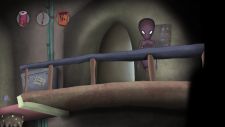|
By flotsam
non
- The First Warp
Lars Pontoppidan / Black Grain Games
I had
a good time with this.
You
play as 'n o n', unexpectedly warped across the galaxy to somewhere, a
somewhere from which you struggle to find your way back to your home
planet of Toukin. Plus, you need to save the galaxy on the way. Portals
feature prominently, whisking you from one place to another place.
Hopefully each whisk gets you closer to home, but who can tell?
The
galaxy is a colourful cartoony sort of place, populated by critters much
the same. Non himself is purply, elongated and alien-familiar, shuffling
about in the third person as he tries to make sense of what is
happening.
The
gameplay is (almost) entirely point and click, and you can save at will
(yay!). Reload any earlier save should you want to, or just click
continue next time you play. There is no spoken word, dialogue being
through speech bubbles, and there are simple ambient sounds as well as a
soundtrack. The latter was too repetitive, but I just turned it down
until it was just the lowest of background music. You can adjust volume
across the board which I always like.
As a
heads up, don’t click during a conversation. You will end it, rather
than progress it. There will generally be an indication in the bottom of
the speech bubble to let you know how much more of the conversation is
to come (2/17 for example). Just let it play out. Ditto everything else
in the game world once you have clicked (again you will get feedback on
how much more is to come). Cutscenes occur which you can fast forward
but I wouldn’t.
There
is no active cursor to tell you where you can do something, but you do
get some feedback after you try. So instead of an icon popping up to say
you can look at this item, if you click on something you can look at you
will get an eye icon as a result. If that sounds a little odd, it is,
but I rather liked it. What it tells you is there is something going on
here, but not until you make a decision to find out.
Like
many games, you find items, combine them, and deploy them in the game
world. Inventory items sit in a ribbon across the top of the screen, and
you click and drag to use or combine. Again, you don’t have activity
hotspots, but again you will get some feedback if you try to use
something somewhere once you try. Or you can drag the item around the
game world and see where it might generate some information.
Unlike
many games, you can manipulate time, once you find the time manipulation
thingamabob. It sits bottom left, and the left and right arrows are used
to twiddle the dial. As you turn it forward or back, the game world
changes in front of you, and fiddling to see what might occur is
essential. Things decay, or grow, or fly past later or just simply turn
from night into day. Too dark in a room? Perhaps its as simple as being
there during the day. Fiddle to see what goes on and then work it into
how you might solve the puzzle in front of you. It adds several layers
to solving many of the conundrums.
Helpfully, time manipulation doesn't effect what you have in your
inventory. If you take an item tomorrow you will have it if you go back
to yesterday.
A
little notebook sits bottom right, which contains hints and to each
puzzle (a little "hoot" indicates a new entry), and its nicely done.
Solve a puzzle to gain access (it works the same way each time so once
you work that out its a tad uninteresting) and then a small number of
pictogram post-it notes will give you insights to the solution. Choose
one, or two or more than that to help, the final clue being flagged by a
big black exclamation point before you look. But if you do, you might
still have to work out how to make it happen in the game world. As I
said, its nicely done.
N o n
might also provide some helpful insights through his musings on things
as you explore. Coupled with the hint system, you shouldn’t be stuck for
too long.
It
took me about nine hours, which was considerably less than the six years
it apparently took Lars to make it. There is fun to be had here.
I played on:
OS: Windows 10, 64 Bit
Processor: Intel i7-9700K 3.7GHz
RAM: Corsair Dominator Platinum RGB DDR4 32GB
Video card: AMD Radeon RX 580 8192MB
GameBoomers Review Guidelines
June 2017
design copyright© 2017
GameBoomers
Group
 GB
Reviews Index GB
Reviews Index |






